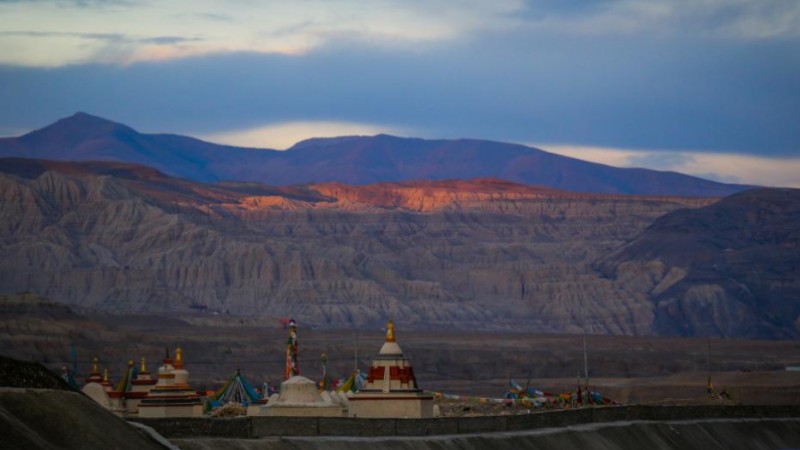Flying Tigers veterans visit Chinese cities, anticipating everlasting China-U.S. friendship
CHONGQING, Nov. 7 (Xinhua) -- Gazing at the youthful face in the photograph on the museum wall in southwestern Chongqing Municipality, tears welled up in Robin Olney's eyes. She took a step closer and tenderly kissed the old photograph.
The man was her father, Richard Olney, one of the Flying Tigers airmen who stood shoulder to shoulder with the Chinese people during China's war of resistance against Japanese aggression.
This photo is now some eight decades old. "He was about 25 years old," said Olney's 70-year-old daughter, adding that the special journey coming all the way around the world, to see her father's photos and the places where he once fought, would be etched in her memory for the rest of her life.
Even though her father never returned to China after completing his mission in 1945, he often shared stories and showed his children a videotape he had recorded in China. "I know he loved China profoundly."
In front of her father's photo, Olney posed for one last photo alongside her father.
SPIRIT NEVER DIES
This scene took place at Chongqing Stilwell Museum, named after the former U.S. general who also helped the Chinese government and people during the fight against Japanese aggression. His former residence in Chongqing is the only museum in China named after a foreign military figure.
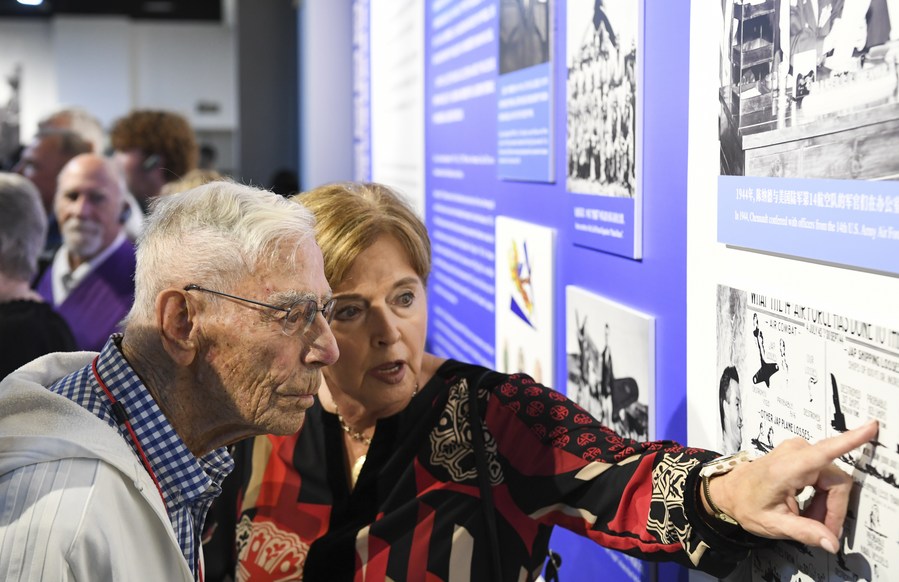
Flying Tigers veteran Harry Moyer (L, front) visits Stilwell Museum in southwest China's Chongqing Municipality, Nov. 1, 2023. (Xinhua/Wang Quanchao)
Olney was in China as part of a 36-strong delegation of Flying Tigers veterans, their relatives and members of the Sino-American Aviation Heritage Foundation.
"I'm very pleased to see such a beautiful museum and the honor that you pay, the tribute that you pay to what these people sacrificed and what they did and that they're remembered here in China, I think is so very important," said Nell Chennault Calloway, granddaughter of U.S. General Claire Lee Chennault.
It was General Claire Lee Chennault who, in 1941, formed the American Volunteer Group of the Chinese Air Force. This team would later be known by the moniker, the "Flying Tigers."
During World War II, the U.S. general trained, organized and inspired both American and Chinese pilots to overcome language and cultural barriers. The "Flying Tigers" helped transport arms and other materials to support China's fight against the Japanese invaders.
At the museum, a Willys Jeep used by the U.S. army during the war caught Calloway's attention and she rode on it. She was deeply touched by exhibits that conveyed information about her grandfather in the exhibition.
"When I came here, I heard the stories of the sacrifices, and what happened during the war and what they were able to do to defeat the Japanese. It's always an inspiration to me," she added.
More than 2,000 Flying Tigers airmen sacrificed their lives during the war. The Chinese people also provided American pilots with assistance at all costs. More than 200 pilots in distress were rescued, and many Chinese people gave their lives during the rescue operations.
FRIENDSHIP EVERLASTING
Flying Tigers veterans Harry Moyer and Melvin McMullen, aged 103 and 98, respectively, were among the delegation.
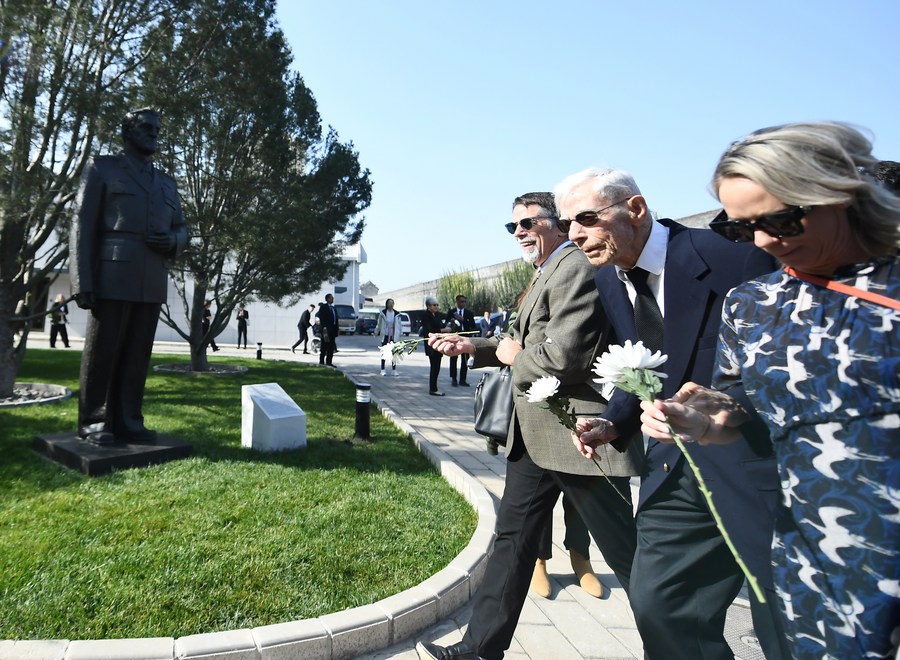
Flying Tigers veteran Harry Moyer (C) presents a flower to the statue of late U.S. General Claire Lee Chennault during an event to commemorate the 80th anniversary of the U.S. 14th Air Force's participation in China's war of resistance against Japanese aggression, in Beijing, capital of China, Oct. 30, 2023. (Xinhua/Zhang Chenlin)
The two veterans presented flower baskets to the statues of heroes who fought against Japanese aggression when attending an event in Beijing on Oct. 30 to commemorate the 80th anniversary of the U.S. 14th Air Force's participation in China's war of resistance against Japanese aggression.
During their visit to Kunming, capital city of Yunnan Province in southwest China, Moyer burst into tears as he sang the song "Auld Lang Syne" with teachers and students at the Kunming Foreign Language School. The school was established to commemorate the famous "Hump" air route, a vital airlift route over the Himalayas and the primary way the Allies supplied China between 1942 and 1945 in World War II.
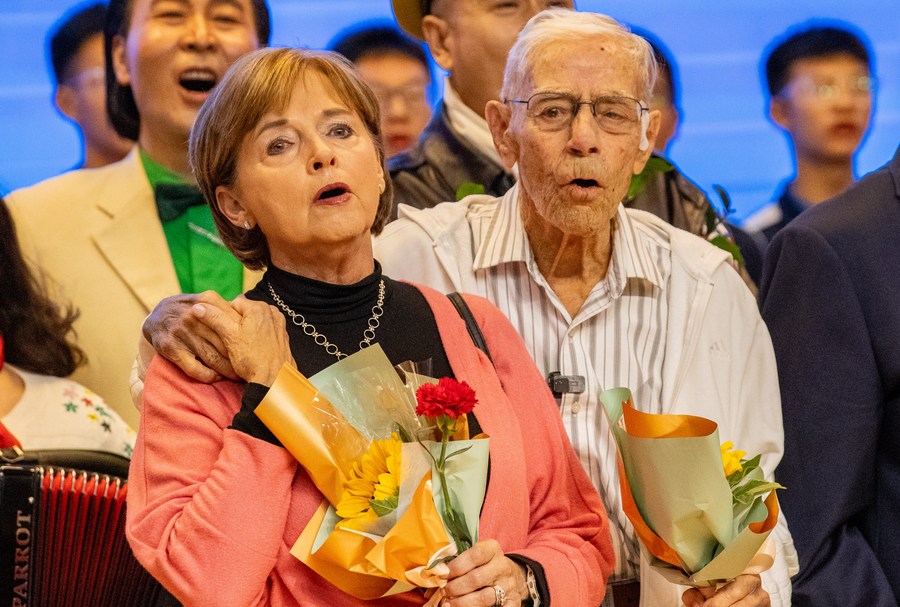
Nell Chennault Calloway (L, front), granddaughter of U.S. General Claire Lee Chennault, and Flying Tigers veteran Harry Moyer (R, front) sing a song during a visit to Kunming Foreign Language School in Kunming, southwest China's Yunnan Province, Nov. 3, 2023. (Xinhua/Wang Anhaowei)
The delegation watched a musical showing the Flying Tigers' adventure to open the Hump route.
The Flying Tigers spirit is an example of how the United States and China can overcome great challenges together, Moyer said, adding that only when people meet and communicate more can they understand each other and avoid misunderstandings.
Moyer and the students planted a cypress next to the monument named "the everlasting spirit of 'the Hump,'" wishing that the tree and the friendship between the United States and China would grow stronger.
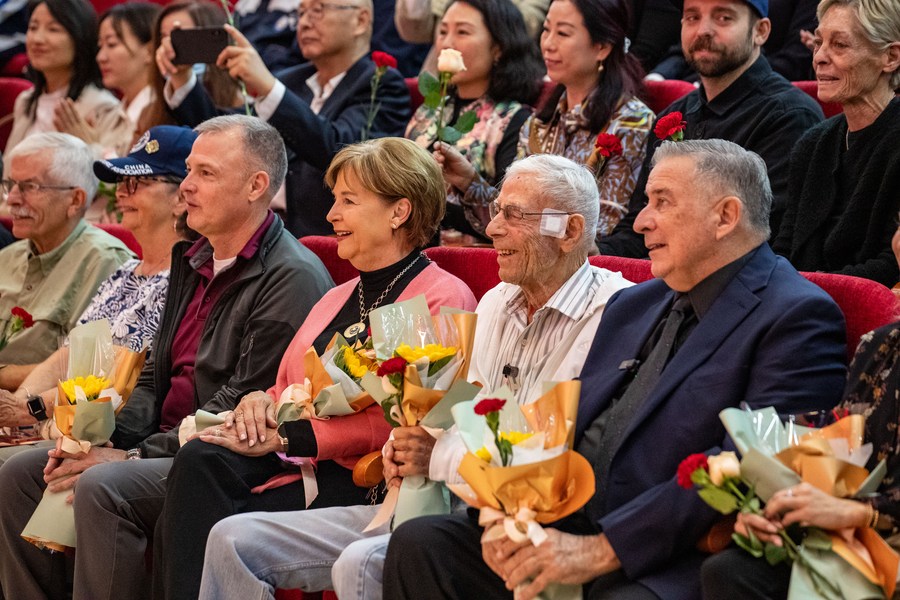
Flying Tigers veterans, their relatives and members of the Sino-American Aviation Heritage Foundation watch a performance at Kunming Foreign Language School in Kunming, southwest China's Yunnan Province, Nov. 3, 2023. (Xinhua/Wang Anhaowei)
The spirit of the Flying Tigers lives on, with countless U.S. and Chinese youth inspired by the friendship.
The Sino-American Aviation Heritage Foundation is dedicated to spreading the story of the Flying Tigers in both China and the United States. An increasing number of U.S. youth participate in programs featuring the heroic spirit, and nearly 500 Flying Tigers veterans and several hundred veteran family members have visited China to revisit history and promote mutual exchange, said Jeffrey Greene, chairman of the foundation.
"It represents the profound friendship forged in history by the blood of the people of the two countries. The Flying Tigers made significant contributions to defending Chinese airspace during the wartime, and their voluntary civilian aid to China laid the foundation for China-U.S. wartime friendship," said Zhou Yong, vice president of Chinese Academy of History of Chinese Resistance Against Japanese Aggression, and president of Chongqing History Association.
The continuation of the people-to-people friendship that started more than eight decades ago demonstrates that people-to-people friendship is the foundation of the friendly relationship between the two sides, Zhou added.
Photos
Related Stories
- Chinese vice premier to visit U.S.
- China to continue encouraging sub-national, people-to-people exchanges with U.S.: spokesperson
- Flying Tigers veterans, descendants visit Liuzhou, S China
- Flying Tigers spirit represents trust, friendship: Flying Tigers veteran
- Entertainment business leaders believe cultural exchanges essential to U.S.-China relations
- Flying Tigers veterans, descendants visit China's Liuzhou
Copyright © 2023 People's Daily Online. All Rights Reserved.








